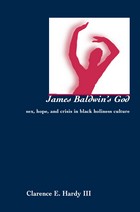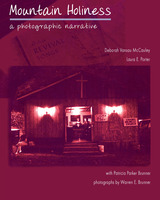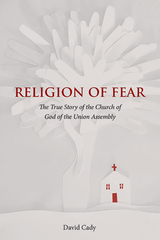3 books about Holiness churches

James Baldwin's God
Sex, Hope, and Crisis in Black Holiness Culture
Clarence E. Hardy
University of Tennessee Press, 2009
James Baldwin’s relationship with black Christianity, and especially his rejection of it, exposes the anatomy of a religious heritage that has not been wrestled with sufficiently in black theological and religious studies. In James Baldwin’s God: Sex, Hope, and Crisis in Black Holiness Culture, Clarence hardy demonstrates that Baldwin is important not only for the ways he is connected to black religious culture, but also for the ways he chooses to disconnect himself from it. Despite Baldwin’s view that black religious expression harbors a sensibility that is often vengeful and that its actual content is composed of illusory promises and empty theatrics, he remains captive to its energies, rhythms, languages, and themes. Baldwin is forced, on occasion, to acknowledge that the religious fervor he saw as an adolescent was not simply an expression of repressed sexual tension but also a sign of the irrepressible vigor and dignified humanity of black life. Hardy’s reading of Baldwin’s texts, with its goal of understanding Baldwin’s attitude toward a religion that revolves around an uncaring God in the face of black suffering, provides provocative reading for scholars of religion, literature, and history.
The Author: Clarence Hardy is an assistant professor of religion at Dartmouth College. His articles have appeared in the Journal of Religion and Christianity and Crisis.
The Author: Clarence Hardy is an assistant professor of religion at Dartmouth College. His articles have appeared in the Journal of Religion and Christianity and Crisis.
[more]

Mountain Holiness
A Photographic Narrative
Deborah Vansau Mccauley
University of Tennessee Press, 2003
“A remarkable achievement. Mountain Holiness combines Warren Brunner’s poignant and sensitive photographs with a succinct narrative by Deborah McCauley, the preeminent authority on Appalachian mountain religion. This is a landmark study that sheds light on one of the most neglected subjects in American religion.”—Randall Balmer, Ann Whitney Olin Professor of American Religion, Barnard College, Columbia University
Hidden deep in the hills of central Appalachia, tiny churches have quietly carried on their worship practices in an unbroken chain for two centuries. Harking back to the camp-meeting movement of the early nineteenth century, independent Holiness churches are considered by some to represent Appalachia's single largest religious tradition. Yet it is one that remains uncounted in any census of American church life because of the lack of formal institutions or written records. Through vivid images and perceptive words, this book documents this rich history, showing how these independent churches have sustained both faith and followers.
The authors spent five years interviewing and photographing Appalachia's Holiness people and participating in their services. From thousands of photographs, they have selected nearly three hundred fifty images for this large-format volume. Here are small one-room churches—many built to hold no more than a dozen people—scattered in the hills of Tennessee, Kentucky, Virginia, and West Virginia. Yet Warren Brunner's striking images depict not only buildings but also the people and their faith practices: river baptisms and homecomings, serpent handling and tent evangelism, radio preaching and special holiday services.
Deborah McCauley and Laura Porter's text combines descriptions of the pictures with the history of the churches and interviews with members. They create a representative window into the material and oral culture of central Appalachia's independent Holiness heritage. Mountain Holiness is a book that will fascinate anyone who cares about these traditions, as well as anyone concerned with the preservation of America's most vital folkways.
About the Authors: Deborah Vansau McCauley is a leading authority on
religion in Appalachia and is the author of Appalachian Mountain Religion: A History.
Laura E. Porter became familiar with Appalachian religion while pursuing a Master of Divinity degree at Union Theological Seminary; she is presently a computer consultant for religious and relief organizations.
Warren E. Brunner is a renowned photographer of Appalachia who has lived and worked in Berea, Kentucky, for nearly half a century. He has published three collections of photographs of the region. Patricia Parker Brunner, his wife, is an ordained Southern Baptist deacon who holds an M.A. in biblical studies.
Hidden deep in the hills of central Appalachia, tiny churches have quietly carried on their worship practices in an unbroken chain for two centuries. Harking back to the camp-meeting movement of the early nineteenth century, independent Holiness churches are considered by some to represent Appalachia's single largest religious tradition. Yet it is one that remains uncounted in any census of American church life because of the lack of formal institutions or written records. Through vivid images and perceptive words, this book documents this rich history, showing how these independent churches have sustained both faith and followers.
The authors spent five years interviewing and photographing Appalachia's Holiness people and participating in their services. From thousands of photographs, they have selected nearly three hundred fifty images for this large-format volume. Here are small one-room churches—many built to hold no more than a dozen people—scattered in the hills of Tennessee, Kentucky, Virginia, and West Virginia. Yet Warren Brunner's striking images depict not only buildings but also the people and their faith practices: river baptisms and homecomings, serpent handling and tent evangelism, radio preaching and special holiday services.
Deborah McCauley and Laura Porter's text combines descriptions of the pictures with the history of the churches and interviews with members. They create a representative window into the material and oral culture of central Appalachia's independent Holiness heritage. Mountain Holiness is a book that will fascinate anyone who cares about these traditions, as well as anyone concerned with the preservation of America's most vital folkways.
About the Authors: Deborah Vansau McCauley is a leading authority on
religion in Appalachia and is the author of Appalachian Mountain Religion: A History.
Laura E. Porter became familiar with Appalachian religion while pursuing a Master of Divinity degree at Union Theological Seminary; she is presently a computer consultant for religious and relief organizations.
Warren E. Brunner is a renowned photographer of Appalachia who has lived and worked in Berea, Kentucky, for nearly half a century. He has published three collections of photographs of the region. Patricia Parker Brunner, his wife, is an ordained Southern Baptist deacon who holds an M.A. in biblical studies.
[more]

Religion of Fear
The True Story of the Church of God of the Union Assembly
David Cady
University of Tennessee Press, 2020
Religion of Fear reveals the story of how a Pentecostal sect, the Church of God of the Union Assembly, a small splinter group of the holiness Church of God movement, evolved into one of the largest and wealthiest cults in America. At its height in 1995, the Union Assembly included fifty-four churches spread across nineteen states. Spanning nearly a hundred years and three generations of family leadership and relying on hundreds of interviews with members and former members, David Cady’s groundbreaking investigation begins, in 1917, with the Church’s illiterate but magnetic founder, Charlie (C. T.) Pratt, summoning a congregation of resilient followers with little more than a flair for spectacle. As power dynamics stir within the maturing Church, Cady turns to C. T.’s fourth son, Jesse, who conspires to wrest the Union Assembly from his five brothers and dismiss his own parents from the church they had created. Jesse dominated the Church with fear and a demand of total obedience from its nearly 15,000 members until his mysterious death at age fifty-six.
As Cady reveals, this event triggered a succession crisis in the Pratt-family ranks as Jesse’s wife fostered her son Jesse Junior’s rise to power and spurned other heirs presumptive to the Church. Jesse Junior turned out to be a tormented leader who drove his followers to the brink of poverty with an uncompromising demand that they give their all to God—and to him. The church’s fortune squandered and its future under threat, Jesse Junior’s mother was finally forced to have her favored son removed and defrocked. For all its troubling twists and turns, Cady’s chronicle ends with a minor miracle, as Jesse’s younger brother, Charlie T. Pratt III, takes over leadership and manages to expel the oppressive air of authoritarianism from the body of the Church and hold the community together in the process.
DAVID CADY is the author of three novels: The Handler, Fatal Option, and Severed. Before his retirement, he taught high school science at Dalton High School in northwest Georgia.
As Cady reveals, this event triggered a succession crisis in the Pratt-family ranks as Jesse’s wife fostered her son Jesse Junior’s rise to power and spurned other heirs presumptive to the Church. Jesse Junior turned out to be a tormented leader who drove his followers to the brink of poverty with an uncompromising demand that they give their all to God—and to him. The church’s fortune squandered and its future under threat, Jesse Junior’s mother was finally forced to have her favored son removed and defrocked. For all its troubling twists and turns, Cady’s chronicle ends with a minor miracle, as Jesse’s younger brother, Charlie T. Pratt III, takes over leadership and manages to expel the oppressive air of authoritarianism from the body of the Church and hold the community together in the process.
DAVID CADY is the author of three novels: The Handler, Fatal Option, and Severed. Before his retirement, he taught high school science at Dalton High School in northwest Georgia.
[more]
READERS
Browse our collection.
PUBLISHERS
See BiblioVault's publisher services.
STUDENT SERVICES
Files for college accessibility offices.
UChicago Accessibility Resources
home | accessibility | search | about | contact us
BiblioVault ® 2001 - 2024
The University of Chicago Press









